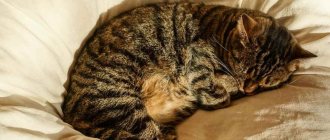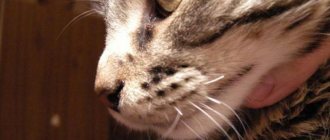Some of the saddest and at the same time ridiculous stories begin something like this: “Our Murka has always been an affectionate cat, but yesterday she almost scratched her eyes out.” Most owners who have experienced what aggression is like in cats don’t even think about the fact that it’s not Murka’s fault. Cats, for the most part, are calm and affectionate creatures that show aggression only for the purpose of self-defense. If your pet hisses, scratches, bites, or shows hostility towards you, family members or guests, you should not blame the animal, you need to look for reasons.
Mysterious cat nature
It is difficult for a person to understand a cat when it becomes wary, hisses for no apparent reason, and stares at the wall for a long time without taking its eyes off. And it’s hard to count how many fantastic theories have been invented on the topic that pets come into contact with the world of the dead, periodically communicating with ghosts. One thing is clear: despite the fact that we see our pets every day, much of their behavior remains a deep mystery to us.
As Hugo noted, a cat was given to a person so that he would have a tiger that he could pet. Sometimes.
In general terms, the solution is very simple. Cats remain predators, regardless of whether they live in the Siberian forests or in a two-room apartment. Predators have certain genetic “programs”—behavioral attitudes that the animal exhibits regardless of the circumstances. For example, herding dog puppies bite their owners' legs because their ancestors herded livestock this way for generations.
Cat and man: friends or enemies?
If you think that by giving your pet a roof over his head and absolute security, you will relieve him of all worries, stress and fears, then you are making a mistake. In conditions of endless supplies of food, a “self-cleaning” tray and an owner who is friendly to the pet, the cat never stops fighting for survival.
It is difficult to give a definite answer to the question of what kind of relationship connects a cat and a person.
A common misconception is that the cat sees the owner as a patron or good friend. Depending on the circumstances, your pet may perceive you as a rival, a terrible pursuer, or even an enemy. In some cases, he may even claim to be a patron himself, bringing you dead mice and taking care of your diet.
Someone believes that for cats we are the same cats with whom we can compete, or we can make peace
It would be incorrect to deny the socialization of a cat that has lived side by side with humans for centuries. Of course, the pet gets used to its owner, whom it sees every day. Remembers those family members who treat him better and experiences positive feelings towards them in return. He recognizes strangers well and, as a rule, is in no hurry to make contact with them.
Cats never allow themselves to completely relax, even with an owner they know very well.
However, if you put aside the flair of sentimentality, you can easily discover that all the affection of felines for their owner sometimes quickly evaporates if there is a chance to escape. Not in all situations the pet takes advantage of this opportunity, but such escapes into the wild are by no means rare.
Affectionate now, cocky in a split second, cats are constant in their impermanence
At the same time, the Internet is full of videos in which an enthusiastic pet runs to greet its owner and throws itself on his neck with a purr. Isn't this proof of great love? Let's understand the contradictory cat behavior.
Features of cat aggression
It is well known that cats are not the type of animal that will show aggression for the sake of aggression itself. Even the most severe predators among felines will prefer retreat to any confrontation. From this we can conclude that in most episodes, aggression is caused either by the owner himself or by circumstances disturbing the cat.
Cats prefer to wait out danger in secluded places.
At this point, confusion may arise. You gave your pet all the best, petted it, fed it, carried it in your arms, and in response it waved its claws. In addition, you also find yourself guilty. Where is the justice?
Cats continue to fight for survival both in the snowy taiga and in a heated room
As already mentioned, each pet has certain behavioral patterns, certain reactions that it produces to certain stimuli. If you seem potentially dangerous to him, the cat will forget about everything you have done for him and turn on the instinct of self-preservation. For example, if there is a lack of shelter hidden from prying eyes, the cat may begin to experience stress and show increased aggression in seemingly safe conditions.
Manifestations of aggression
Let us dwell on the characteristic external manifestations of aggression, well known to all owners:
- Convulsive twitching of the tail, tapping it on the floor.
- Muscle twitching in the back area.
- Sudden change of posture, unnatural arching.
- Acoustic alerts - loud meowing, hissing.
- Increased avoidance of the stimulus.
- Unexpected scratching of the legs under the table;.
- A sharp jump from cover onto a person.
- Swinging front paws.
All these changes in the pet can be called signals that it gives to the owner before the attack. For what? To resolve the situation peacefully. If the owner is sensitive and listens to the pet’s “message,” the cat’s aggression will gradually fade away.
Giving advance warning of your displeasure is an essential cat trait.
It is important to remember that an attack of aggression never occurs suddenly, out of context (with rare exceptions). In order for the cat to take action, the owner must ignore a number of warnings. Sometimes it can be very difficult to understand what exactly the cat didn’t like. The following list of the most common “reasons for dissatisfaction” with your four-legged friend will help you understand the dilemma.
Categories of cat aggression: what's wrong with your cat
There are reasons for everything, everything has a consequence, and there are no hopeless situations. The owner panics: “The cat is aggressive! What to do?!" will not lead to a positive result.
First, you need to calm down. Secondly, figure it out. Thirdly, begin correction and treatment. If the cat attacks or behaves inappropriately, follow this simple algorithm.
Calm down, master!
A person is only able to help an animal when he himself is calm and reasonable. The emotional life of animals is no less eventful than ours. Therefore, any human reaction is perceived by the animal as a signal to action.
Something else interesting: How to stop a cat from shitting
The calmer a person who is authoritative for your pet behaves, the greater the chances of getting out of an aggressive situation safely, without harm to your own and the cat’s health.
RULE OF ZOO PSYCHOLOGISTS!
Movements are calm, smooth, even if fast. We act persistently and methodically. This rule is useful at all stages of communication with the aggressor.
Let's understand the reasons
Find the root of evil - in this case, this phrase should be taken almost literally. If we are not talking about veterinary reasons, such as rabies in cats, pain syndrome or bad heredity, then you will have to study cat psychology.
It’s paradoxical, but the term “unjustified aggression” exists, but it itself does not. There are always reasons and they can be found.
Since scientists love to classify and put everything into categories, they have identified three main categories of aggressive behavior in cats (in fact, these are the reasons why the cat became aggressive):
- Predator aggression is a reaction to the presence of a real or imaginary victim (which may well be a person, if the kitty does not know how to correlate its own size with the size of the “prey” and make the right decision);
- Intraspecific (sometimes called intermale) aggression. Quite often, a cat cannot get along with its own kind, personal and territorial skirmishes and fights begin;
- Caused by fear (the reaction of a “rat driven into a corner” - a very desperate defense of the space around oneself). The less space left, the angrier the animal;
- Irritation, as a response to a whole range of external stimuli (for example, pain, limitation in something), can be directed to living and inanimate objects;
- Defense of the territory (from any strangers - people, animals, objects);
- Maternal - a pregnant or recently calved female attacks any “stranger”. Strangers can include acquaintances and even family members;
- Instrumental - a learned response aimed at obtaining reinforcement. Most often it occurs in a situation where a dangerous animal is bought off with a piece so that it doesn’t come close.
- Sexual aggression is a reaction to rivals of any gender during the struggle for a partner.
The author of this classification (Moyer) notes that there are no “pure” types of behavior; they are always intricately intertwined and dependent on each other. There are some peculiarities in the correction. For example, a predatory reaction directed at a person is subject to change, but if the victim is someone more suitable (an animal), the reaction is almost impossible to block.
Scientists Young, Hope, Reisner, Chapman identify several more groups of abnormal behavior:
- Play aggression is a special type of reaction. Most often, the carrier of this “diagnosis” is an aggressive kitten (sometimes wrongly);
- Redirected aggression is one of the most common problems in the practice of felinologists and zoopsychologists. The reaction of fear, pain or competition can be redirected to an object nearby or to a part of the person’s body;
- Aggressive behavior directed at a person is already a conscious behavior, a kind of interpersonal conflict that the cat enters into at every meeting. A specialist should understand the reasons!
- Conflict directed at low-ranking individuals (aggression of self-affirmation). Most often we see this when there are several cats in the same house. From time to time they quarrel among themselves, more often they make do with demonstrations of force, but quite brutal fights also happen;
- Anger, the cause of which is not clear, is a reason to contact experienced veterinarians for a full examination of the nervous system and general health (for example, a kitty may have epilepsy or obsessive-compulsive syndrome).
Something else interesting: Cat rabies
If an angry cat becomes uncontrollable, it is best to contact a specialist and not waste time searching for the reasons on your own. There is such a pattern: an attack reaction that appears once is random; Once it is repeated at least one more time, it will become firmly rooted in the pet’s behavioral arsenal. Without the help of a specialist, the owner can only determine the direction of the search:
- If a cat begins to behave badly, rushing to bite only in the presence of other cats, this indicates an intraspecific type of reaction;
- If the reaction is directed only at people, it is a matter of self-affirmation and gaining status;
- If both people and animals, and sometimes objects, become targets of attack, then the range of possible problems is too wide for self-correction. And idiopathic (unexplained) aggression cannot be treated at home at all.
Intraspecific aggression
Sometimes we hear the squeals of cats clinging to each other under the windows, ready to make any sacrifice to defeat their opponent. After such battles, doubts begin to arise about the prevalence of peaceful solutions to the conflict over confrontation among cats. But it's not that simple.
Rivalry between cats does not occur because of “harmfulness”, but due to the implementation of a number of instincts
The struggle of cats who find themselves in the same territory is directly related to the instinct of self-preservation. A defeated cat risks being expelled and left to its own devices. Why do these animals pull out each other's hair?
There is a continuous struggle with competitors for both status and territory.
Firstly, every fight is a matter of status. It is more expensive for yourself to be in last positions in the hierarchy. Secondly, the outcome of the collision will directly affect the cat’s future territory of residence. In cat fights, the stakes are always high, and it doesn’t matter whether it’s a fight for a piece of forest for hunting or for a cozy corner by the stove. Territorial aggression can also manifest itself towards a stray cat with whom your pet is playing an intense game of staring contest.
By the way! In addition to direct clashes, animal aggression towards each other can manifest itself indirectly. For example, by marking the territory by spraying urine.
Reasons for displaying aggression
Among the situations in which aggression occurs between cats within the same home, the most common are the following:
- the arrival of a new pet in the family;
- competition for limited resources (food, resting place, love of the owner, litter box);
- long absence of a previously familiar pet.
The reasons for confrontation can be very different - from the owner’s attention to one’s own litter box.
From this we can conclude that intraspecific aggression can arise both between unfamiliar animals and between animals that have lived under the same roof for years. Sometimes even a long absence of a pet is not necessary - cats that have lived in perfect harmony can suddenly cling to each other for the owner.
What can the owner do?
In intraspecific clashes, the role of the owner is minimal, so he cannot always influence reconciliation. Clashes can worsen during periods of hormonal surges and resolve on their own.
If the owner does not have the opportunity to isolate the cats from each other, castration may be a compromise.
In extreme cases of rejection, it may be worth considering moving one of the pets to a safer location. It is also advisable to take into account the size of your home and the distribution of active zones for each cat. The less space you have, the fewer pets you should have to avoid competition.
You can effectively reduce the level of aggression through castration, after which it will be easier to calm your pet. However, for those who plan to raise a cat dynasty, this method is hardly suitable.
What to do if your cat gets angry and shows aggression towards you?
The best way to deal with an animal's aggressive behavior is to switch your pet's attention to, for example, a toy, this could be an artificial mouse with a catnip scent or a small ball.
But what to do if the cat is angry (growls, scratches, bites), and you still cannot understand the reasons? Of course, it is worth stopping the “villain”, but under no circumstances should you use brute force. You can resort to the methods with which a cat raises its kittens, for example, hissing yourself or giving a light but lightning slap on the back of the nose. This should not only greatly surprise your pet, but also stop him. Another proven method is a cooling spray shower. After educational measures, you should not immediately pet the animal or feed it.
Redirected aggression
This type of aggression is very difficult to identify, since it requires good knowledge of the pet’s character and analysis of its behavior. The meaning of redirected aggression is to move the reaction from a stimulus that is inaccessible to the pet to an intermediary object that costs nothing to reach.
Redirected aggression allows the cat to cope with pent-up tension and let off steam.
Many owners have noticed with what interest the cat watches the birds landing on branches and flying away. Sometimes the pet even makes typical hunting movements - swings its paw, jumps. It seems that he is all in the process of chasing... imaginary birds. The window does not allow the cat to realize its hunting instincts and leaves it in a state of frustration.
Often the reason for aggression is what is happening outside the window, be it a missed bird or an unbeaten neighbor's cat.
A similar scenario occurs if your pet sees a cat in the yard with whom he wants to settle scores. The need for release does not disappear anywhere, and here, very opportunely, the owner turns up, whose leg the four-legged friend grabs onto. This “consolation prize” could be another animal in the house, wallpaper, or sofa upholstery. In this situation, it is easy to see how territorial and redirected aggression are intertwined.
What can the owner do?
The only thing the owner can do is understand and forgive his pet. Home conditions inevitably involve daily doses of “frustration,” which cats put up with as best they can.
At home, cats have to periodically suppress themselves, limiting the instincts of the hunter
What can we say, redirected aggression in a slightly modified form is also characteristic of humans. The very need for relaxation is extremely important - if the owner begins to respond to aggression with aggression, the cat will fall into a depressed state.
Important! Redirected aggression is most often confused with causeless aggression. The consequences of such indiscriminateness can be disappointing - up to and including prescribing tranquilizers to the cat that it does not need. Remember that cases of unreasonable aggression are very rare compared to redirected aggression.
Aggression during petting
One of the most mysterious types of aggression, noticed by all owners, is aggression shown at the moment of true bliss of the pet. Here he sits on your lap, you brush him or stroke him behind the ear, the cat purrs and has a great time. But in the next seconds his mood changes dramatically. He calms down, jumps up, hisses and tries to bite the owner who has come in peace.
From rumbling to attack - one step
The main difficulty with such incidents is that the cat will not tell you “enough is enough” in human language. But if we try to take the place of a cat, we will easily understand that all caresses are good in moderation. It is reasonable for the owner to ask himself the question: “Do I know this measure in relation to my pet?”
Of course, there are no general recommendations or advice on when it is advisable to stop squeezing your pet. The need for tactile proximity is different for all animals. The simplest indicator that the cat has received everything it needs from you is the subsidence of the rumbling. But some pets do not purr at all, so this sign cannot be universal.
Among the cats there are quite a lot of touchy-feely cats who don’t like letting their hands go at all.
There may be several reasons for a sudden change in mood, but most often they can be divided into three groups, related to each other:
- the owner touched one of the “forbidden zones” on the cat’s body, which no one is allowed to touch. The fact that not all parts of a cat’s body are accessible to the owner has been played out ironically more than once. But even from comic sketches on this topic and from personal experience, we can conclude that “taboo”, as a rule, are the paws, tail and (most often) belly;
- the owner did everything right, but did not show moderation. Too intense stroking can lead to overexcitation of the pet, which is physiologically assessed as something unpleasant. Such unpleasant moments can only be prevented by the owner understanding the message “enough is enough” on the part of the cat;
- the owner made no mistakes, but still got it. In rare cases, cats may exhibit congenital tactile hypersensitivity, in which they themselves cannot calculate in advance their “measure” of tenderness.
Thorough licking of itself after an attack indicates an attempt by the pet to restore balance.
Often, after an attack of anger, cats go to a secluded place and begin to make themselves beautiful. This behavior in scientific language is called “grooming” and aims to cope with aggression by redirecting it into a creative direction.
What can the owner do?
All breeds are individual, moreover, all cats are individual. Predisposition to affection varies from one individual to another. It’s up to you to listen to the unambiguous hints that your cat has had enough of the attention given to him and is not asking for more.
Recognizing a cat's "no" will help the owner keep his arms and legs safe
Some breeds, for example, orientals, are cooler about displays of tenderness. Some cats can do without it and live in peace. The owner can only accept the fact that tenderness towards the pet is not always a joy for him. The sooner you leave the myth of the cat as a purring, touching lump, the easier it is to establish contact with your domesticated predator.
One should not expect outbursts of tenderness from oriental breeds either.
By the way! In the category “touchy” you can safely write down the nature of wild cats, which are purchased by people who want to dilute their lives with exoticism. These owners sometimes do not realize the difficulties that accompany life with animals. Forest and desert cats and Pallas cats are not accustomed to the human hand and do not feel the need for affection. You can read about the specifics of keeping wild Amur and sand cats on our portal.
Reasons for aggression
There are many reasons for aggression. The most common of them are :
- Hormonal disbalance . This reason occurs in uncastrated cats. If the animal is not castrated or sterilized before the age of one year, then hormones will be constantly produced, tormenting the pet and its owner. If sterilization is not an option, then you will have to match the fluffy with the opposite sex. Otherwise, an aggressive cat, while in the apartment, will show aggression in every possible way: biting, scratching, meowing loudly, going to the toilet in the wrong place, etc.
- Competition . Confrontation between two animals is the most common cause of aggressiveness in cats. It doesn’t matter whether another cat or dog appears in the house, the pet will show aggression in any case. Hissing, attacks, jumping, fighting - the outcome of any confrontation. It is necessary to be able to wean your cat from attacks on new residents or guests.
- Pain . A common cause of aggression is pain. If a cat is in pain, then it will by any means withdraw from communicating with anyone. Any touch will be accompanied by self-defense, namely, aggressive attacks. If an aggressive pet is injured or sick, it is best not to touch it.
- Poor nutrition . If you feed your cat the wrong and low-quality food, then it is likely that she will resist eating. The same goes for food that is not intended for feeding cats. If you are concerned about your pet's condition, consult a veterinarian who can help you create a balanced diet for him.
- Fears . If the kitten is not socialized in time, then at a later age it will turn into a shy cat. Any rustles or strangers will frighten him, which will subsequently result in aggressive behavior. It is necessary to constantly walk the cat, introduce it to its relatives and other people. Sometimes an adult cat who is developing socially correctly can become very frightened.
- Motherhood . It is not recommended to approach a cat that has recently become a mother of furballs. The new mother will try in every possible way to protect her babies from the outside world. It is best to provide the cat with everything it needs and not get too close to it.
Identifying the cause will allow you to quickly cope with aggression and avoid unnecessary consequences.
© shutterstock
Aggression based on fear
Every owner who has once taken a cat to the veterinarian has encountered symptoms of this type of aggression. The pet spreads its paws, shows its fangs, and hisses. At any opportunity, he strives to slip out of the hands of a specialist and hide in a safe place. In the worst cases, it flies around the office, destroying everything in its path. In a state of passion, cats are capable of any miracles of acrobatics.
If a cat is scary in anger, then in panic he is three times more scary.
Similar behavioral attitudes can manifest themselves when meeting strangers, and when riding in a car or public transport. Aggression caused by a feeling of fear manifests itself in all cats, even the most sociable ones. But its severity and frequency of occurrence depend on the pet’s living conditions.
Prerequisites
The basis on which the feeling of fear will be based in the future is laid at an early age. It is believed that a kitten must necessarily spend the first months (preferably three months) next to its mother in order to satisfy its need for security.
If the cat did not receive enough maternal attention as a child, it will develop trust issues as an adult.
An early weaned kitten is more likely to have problems trusting anyone. This is especially true for kittens found on the street who have had to deal directly with fear, the threat of death and loneliness.
Cats walking on their own are unlikely to be tamed, maintaining their independence
Wild or stray cats who grew up without knowing human love are also at risk. Getting used to human hands happens to a kitten either in the first two months of life, or never happens. Of course, even adult cats gradually accept their permanent owners, but continue to treat them with great suspicion.
Reactive and preventive installations
If in domesticated cats aggression is more rational in nature (it is a response to an irritating stimulus), then in conditionally “wild” cats aggression becomes the basic mechanism of interaction. Every living creature is fraught with potential danger for them. To summarize, we can attribute manifestations of aggression to two fundamental behavioral attitudes:
- the reactive installation involves mobilizing the cat if necessary. Aggression is a response given to a cat's life-threatening stimulus;
- The preventive attitude determines the cat’s behavior as a whole. Aggression is a learned pattern of communication with the enemy, which everyone is, regardless of the actual degree of threat.
What can the owner do?
The best thing an owner can do in such emergency situations is not to do anything they would like to do. Namely, you should not immediately try to calm and reason with the animal, or pick it up. Fear is a strong affective state, so the best solution would be to allow the affect to take place and outlive itself.
The right decision when a cat is overcome by passion is to wait it out in conditions that are comfortable for the pet.
The more active your calming actions are, the more reasons the cat will have to suspect that you are the source of danger. Let the pet hide in any secluded place that he likes and wait out all the panic manifestations there.
During acute attacks of fear, you can help the animal by covering it with a box or wrapping it in a thick blanket to remove the irritant causing an acute reaction from sight. In a box or under a cloth, the cat will feel protected and will come to its senses faster, regaining strength after the adrenaline rush.
If possible, it is advised to avoid touching the cat at such moments - they will provoke an attack of aggression.
Important! All your actions aimed at calming the cat should be as smooth and careful as possible. Any sudden or awkward action can provoke a new aggressive outburst of the pet.
Play aggression
Sometimes the reason for a cat’s aggression lies on the surface: cats are playful by nature and aggression in some cases is increased playfulness. The main sign of playful aggression is suddenness.
© shutterstock
If an aggressive kitten is actively playing with a ball or jumping around the corner at one of the household members, be sure that the fluffy one is simply bored and wants to have fun. Sometimes overly playful cats jump on their owners or cling to the top of the curtain. A particularly active and aggressive kitten rushes around the room sideways, arching its back, sharply slowing down my direction. In rare cases, an aggressive cat may try to bite or scratch during play, but in most cases such pranks do not cause any harm.
You should not try to calm the cat down, because it may become offended and its aggression will increase . It is best to take time and play with your pet. Cats love to hunt, so you can play chase or hide and seek.
Aggression associated with gaming installation
Sometimes our pets begin to behave in the most bizarre way - they jump out of hiding and rush to the discouraged owner. After the prankster has been noticed, he hurries to disappear from sight again to repeat his triumphant attack.
Measuring strength during play is clearly not the prerogative of cats
In some cases, jumping out is accompanied by harmless scratching of the owner’s legs, which does not leave wounds. But sometimes such antics can leave behind bloody marks on the owner who remains perplexed. Some of the most harmless advances include the following:
- gentle biting of the owner’s legs or arms;
- fast running back and forth;
- light patting with a paw;
- attempts to jump to the owner's hands.
It would seem that the pet was not frightened, upset, or worried about anything. Didn't feel thirsty or hungry. On the contrary, stereotypical actions were more reminiscent of an abstract game of tag. But at a certain point they were complemented by excessive aggressiveness, which was not typical for the game.
Kitten games are not always as harmless as they seem at first glance
To understand this behavior, one should again turn to the pet’s possible problematic childhood, in which the basics of its mental constitution are laid. Many of us have witnessed the touching games of kittens, jumping on each other, biting their comrades by the tail, and so on.
From the outside, all these actions look harmless, but their instinctive background leaves no doubt - these are young hunters. In the strict sense of the word, the relationship between kittens cannot be called a game. It would be more accurate to call this the preparatory phase, during which the elements of predatory behavior are absorbed, which is normally realized as one grows older. At the right moment, the skills acquired during the “game” are redirected to mining.
There are both very playful pets that do not give the owner passage, as well as phlegmatic individuals
If something goes wrong and for some reason the kitten is separated from its mother and its brothers and sisters, it fails to establish the boundary between “play” and full-fledged predator behavior. Cats that gain independence too early literally “get stuck in childhood,” unable to correctly complete this stage.
Remember that proper setting of boundaries between you and your pet is the key to a good relationship
As a result, the owner gets what he gets - syncretic play behavior that conceals unrealized hunting attitudes. Since the pet does not feel the line between the first and second types of behavior, it can move from innocent flirtations and foolishness to quite serious combat manipulations without noticing. Hunting instincts will sooner or later make themselves felt at inopportune moments, unexpected for the cat himself, when he is “playing”.
Sometimes a cat, even with the best intentions, may not calculate his hunting prowess
Usually, behind all the advances there is one goal - to attract the attention of the owner. But since the cat cannot spend its energy resources as intended, their excess can be expressed in a lack of sense of proportion.
Video - British kitten games
What can the owner do?
Since the cat comes in peace by flirting with you, the best option would be to satisfy his need for play. For such cases, it is advisable to have several toys in the house that serve as mining simulators.
Don’t forget to pamper your pet with toys and your attention from time to time.
They should be easy and safe to chew, throw, scratch with claws. In a word, you need to try to create conditions as close as possible to the hunting conditions that your pet so lacks.
Important! Do not use your own hands or feet as bait during play if you do not want your pet to periodically have hunting sessions for parts of your body. The sooner the boundary between the cat and you is marked, the better it will be for your limbs.
Aggressive behavior in cats: prevention and treatment
Contents hide
Aggressive behavior in cats: prevention and treatment
Today we, dear readers, will talk about deviations in the behavior of cats. In letters from many of our subscribers there are complaints about unmotivated aggression in furry pets. At one point, we realized that we should prepare a separate material - the topic turned out to be so relevant. We give the floor to our colleagues from America.
The problem really exists: until recently, an affectionate and calm cat suddenly changes its behavior to a minus sign, rushes at its owners, bites and scratches. Let's figure out where cat aggression comes from.
General idea. Aggression in cats is the most common behavioral problem, and it is, unfortunately, as old as time. Moreover, what we call aggression actually fits perfectly into a cat's nature. In most cases, negative changes in a cat’s behavior can be corrected directly at home. You should seek the help of professional specialists and use medicinal treatment methods only when the animal becomes downright dangerous.
“Aggression in cats” is a collective concept. There are many reasons for the aggressive behavior of our furry pets: fights between cats; territory protection; fear/defense; aggression during games; predator instinct; redirected aggression, some other reasons. In all of the above cases, the animal can be helped. If it doesn’t work out, then we’ll treat it.
The first step is to talk to your veterinarian. It is necessary to know his opinion about the nature of your pet’s aggressive behavior. The doctor will help determine whether serious intervention is required; perhaps the aggression is hiding some serious illness. Once it becomes clear that the problem is behavioral, you should move on. Perhaps your attending veterinarian will give you some practical advice, or he will advise you to make an appointment with a specialist.
Symptoms and identification. Cats are quite complex and sometimes contradictory creatures. There is no need to hope that you will be able to get to the bottom of the negative changes in their behavior right away. Moreover, aggression must be diagnosed, separating it from normal cat behavior: many animals have a “tough” disposition from a very young age. You'll have to come to terms with the fact that you just came across such a pet. However, let's move in order.
A cat exhibiting fear or defensive behavior is a behavior that almost all owners can experience. How does your pet behave when he realizes that he is going to the vet? The animal first arches, and then, as it were, everything shrinks, tucks its tail under itself, and its ears move back.
Objects of aggression are other animals (cats). Does your pet spend most of its time outside? Then he has something to “talk” about with the neighbors’ cats. Do you have several cats in your home and are you keeping them indoors? And this happens - animals simply cannot get along.
Your cat fighting on the street is a normal behavior for unneutered street cats. Cat fights occur at lightning speed: cats sort things out over territory, over food, over beautiful ladies, etc.
Aggression as a defensive reaction to the pain experienced. You will receive a strong rebuff from a sick pet if you try to cuddle it or pick it up (options are possible).
Play aggression. Most often occurs during games between cats. Aggression is also possible towards the hosts when they go a little too far during the game.
Aggression as a manifestation of the predator instinct. Actually, cats have always been and remain predators by nature! See how a cat behaves when it tracks, chases and finally catches its prey - small rodents and birds. However, cats sometimes “forget” who they are dealing with and begin to play predators with their owners. A sudden jump or throw, a strong bite, a cat holding the “prey” with its teeth, trying to “shake” it - all this is, to say the least, very unpleasant. Kittens absorb this behavior with their mother's milk, and hone their first hunting skills on their brothers and sisters.
Redirected aggression. This phenomenon is also common. How does this happen? Your cat, for example, may quarrel with the neighbor's cat and hatch plans for revenge. But he soberly assesses his own capabilities - his offender is larger, stronger, and you cannot take him with your bare paws. And evil accumulates! And then the animal unleashes all its rage on someone else - for example, on another weaker cat, or on a neighbor, if you have several cats at home.
Territorial aggression. Everything is clear here: your cat will defend its territory from claims from other cats.
Petting-induced aggression. Often it literally comes out of nowhere. You caress your pet, it purrs sweetly and seems to be happy with everything. Suddenly he bristles sharply and inflicts very painful bites. As experts joke, “a cat bites out of great love,” but this doesn’t make it any easier for the owners. By the way, the nature of this phenomenon has not yet been very well studied.
How is the diagnosis made? The veterinarian follows a standard path: he clarifies the sex of the animal, whether it was castrated/sterilized, when and under what circumstances aggression first appeared, and whether there are negative dynamics in behavior.
The breed of the animal is not specified - aggression manifests itself in animals of all breeds without exception.
Treatment. In many ways, as noted above, it depends on the type of aggressive behavior. In the vast majority of cases, corrective techniques work well. You will be advised to spay or neuter your animal if these operations have not been performed before. In advanced cases, the veterinarian will use drug treatment. If you doubt your abilities, on the advice of a veterinarian, be sure to visit specialized specialists (in cat behavior, for example).
Prevention.
In many ways, the root cause of aggression is the lack of proper attention to the animal on the part of the owners. Most often, cats become aggressive when left to their own devices, whose owners have decided that their main mission is to put food in the bowl on time. You should work with a kitten from a very tender age, socialize it, teach it to live in a large and complex world where you will have to interact with other people and animals. Care and housekeeping are your main preventive measures! Original publication: Aggression in Cats. Source and photo:
Maternal aggression
A cat's behavior after giving birth can vary from absolute indifference to kittens to excessive vigilance and bursts of aggression towards anyone who approaches her “nest”. Even the owners will not escape the cat's righteous wrath if they violate boundaries.
The postpartum period is full of worries and fears for new mothers - show understanding for them
The change in the hormonal background of the pet is to blame for the changes that have occurred. It should be borne in mind that a cat’s behavior can change both before and after birth. Before getting kittens, it is advisable for owners to imagine what changes in life they will face.
Even during pregnancy, the cat will inspect the territory of your house for a successful location of the nest with future cubs. After their birth, the mother will begin to guard this territory with all the frenzy that is in it. Therefore, there are often cases in which the owners, having violated the “forbidden” boundaries, found themselves under the gun of an aggressive mother, ready to make a sieve out of anyone who passed for an enemy.
The cat's increased concern for the safety of her babies will gradually subside as they grow older.
This type of aggression in the vast majority of cases does not require correction. Through such sometimes excessive (in human opinion) protection, the cat implements its instinctive program, which combines the maternal instinct and the instinct of self-preservation.
To understand your pet's concerns, you need to go beyond thinking within four walls. We repeat: cats are predators, designed to live in difficult conditions. All those precautions that seem unnecessary to humans allow cats to survive.
Think in advance about the location of the space with dim light and sound insulation for kittens
Of course, a fox, wolf or bird of prey will not sneak into the apartment to drag away the kittens. But this does not mean that a cat's instincts will undergo rapid changes in a safe environment. After the birth of kittens, your pet begins to selflessly fight for their lives. Nothing can be done about it.
By the way! The cat may begin to attack the father of the family, seeing him as a threat. Such illogical, at first glance, behavior, unfortunately, is justified by cruel experience. In cat communities, adult cats often attempt to kill kittens, which allows the cat to classify them as the most dangerous enemies.
What can the owner do?
The best thing an owner can do for a recently lambed pet is to move away from her nest to a safe distance. Remember, if a cat feels that her kittens are not in danger, she will not resort to aggressive behavior. It is advisable to give the young family a separate room. If there is none, at least a separate corner.
Mother cats are very sensitive to every rustle, so as not to alarm them, avoid sharp sounds
It is not recommended to call your cat often, as it reacts sharply to extraneous sounds. It is enough to leave food in her bowl and stroke her occasionally, without trying to be too intrusive. As the kittens grow older, the hormonal levels of the mother cat will level out, and aggression will gradually subside until it disappears altogether.
Video - Realization of maternal instincts
Breeds of the most aggressive cats
Animals go into a rage under three conditions: pain, fear, or in the heat of competition. The most aggressive cat breeds are Siamese, Angora, British, Persian.
Siamese cats
The breed is distinguished by vindictiveness and a desire for revenge. Owners of Siamese cats are often attacked and left with bitten or scratched. If a representative is unintentionally or deliberately offended, then he can harbor anger for the rest of his life and rush at every opportunity.
Siamese do not tolerate neglect and familiarity, or excessive attention to their own person. Such pets are not recommended for families with small children out of fear for the children’s health. Animals do not tolerate competition - if there are other cats in the house, then it will quickly begin to resemble a war zone.
The main option for a Siamese cat is a single person who can cope with the pet's outbursts. In this case, an ideal tandem is obtained - peaceful coexistence without constant conflicts.
White cats
Mental instability may be associated with a defective cat - most snow-white cats with blue eyes suffer from deafness. Vulnerability, fear and the instinct of self-preservation lead to constant hostility without reason or external stimuli. Cats defend themselves just like that, without serious reasons.
White aggressive cat
Blue cats
Pets, painted in gray-blue colors, are naturally distrustful and timid. Attempts to show persistence on the part of a person end in “licking” wounds from claws and teeth. Remembering the aggressive breeds of domestic cats, we can say that anger is inherent in the Persian and British breeds - their freedom-loving nature does not allow them to obey and do something against their wishes.
The British have a rich imagination and changeable moods. Before attempting to invade the personal space of a breed representative, you need to make sure that he is in a good mood - otherwise you may receive a warning hiss and a sharp blow with a paw with extended claws.
Veterinarians believe that most attacks on people are provoked by competition for the right to be called the alpha male in the pack. In males, testosterone is released along with sweat, in females - estrogens. They cause bursts of rage that arise under the influence of sexual instincts. It has been noticed that females attack women more often, while males attack men. Lonely people are better off having pets of the opposite sex: the smell of sweat from a person causes sexual arousal and the production of endorphins.
Aggression in cats does not arise due to the bad character of the furry pet or gloomy mood. If you correctly determine the source of the problem and remove the irritants, you don’t have to worry about the integrity of your skin—the pet won’t attack its owner.
Aggression caused by pain
Our pets cannot show where they are hurting, which sometimes makes it difficult to identify the real reasons for their behavior changes. Aggression associated with pain is easily confused with other types. It can be mistaken for an unreasonable “whim” or for overexcitation during affection.
Aggression in response to inflicted pain can manifest itself both when the tail is crushed by a careless owner, and when there are dangerous diseases of the pet’s internal organs, which are impossible to guess without the help of a specialist.
Frequent irritability in a cat may indicate health problems
By the way! Elderly cats should be handled especially carefully. In old age, they may develop arthritis, which causes pain if the pet is not handled carefully.
Painful aggression can also be combined with the above types. For example, while brushing or stroking a cat, you notice that it changes favor to anger whenever you touch a certain part of its body. If this behavior is repeated many times, then you need to pay attention to it. You can also read about the most common cat diseases on our portal. If a physical illness is suspected, it is advisable to have your pet checked by a veterinarian for possible minor injuries or illnesses.
Aggression after sterilization
Attacks of anger experienced by pets after sterilization are a special case of aggression caused by pain. Many owners mistakenly try to cheer up their pet with all sorts of games and treats, not realizing that after surgery, the best thing that can be done for the cat is to give it a rest.
Sterilization is difficult for a pet both physiologically and mentally.
There is no point in running for sedatives. As a rule, a change in a cat's mood is associated with poor health. Coming off of anesthesia, the first days with a slowly healing wound - these conditions can hardly be called easy. Therefore, if you want to help your pet with medications, then pay attention to painkillers.
The main task of the owner after sterilization of the pet is to provide him with rest and painkillers.
Important! Feeding your pet during the first 24 hours after sterilization is strongly discouraged. It is enough to give him water to avoid dehydration.
Special attention should be paid to the pet’s experience of anesthesia, which leaves an imprint on the pet’s mental state. Some cats may have poor tolerance to the gas used during surgery, which only complicates the situation.
What can the owner do?
Everything is the same as what is done to people who have undergone a complex operation. Give your pet peace and provide him with the necessary, but not intrusive, attention. Remember that anesthesia could affect the pet's coordination, and do not leave it alone for a long time - the cat may accidentally harm itself.
Treatment of aggression in cats
When raising the question of treating his pet, the owner usually finds himself captive to a very dangerous prejudice. In general terms, it sounds like this: it’s enough to take a prescription for some tranquilizer and give it to the cat so that it is calm and docile.
As practice shows, the real need for medications appears extremely rarely. At the same time, it is very easy to harm a cat’s nervous system with illiterate medicinal intervention. Since covering the range of medications that “calm” pets within the framework of this article is an impossible task, we will focus on alternative, easier treatment regimens.
Drug treatment is prescribed only in rare cases associated with pathologies of the nervous system
In their book on behavioral medicine for dogs and cats, Horwitz and Mills provide a list of methods that are not radical drug interventions, but have a positive effect on the pet. Let's stop at them.
Table 1. Methods for treating aggression in cats
| Therapy | Description | Peculiarities |
| Phytotherapy | It assumes a milder effect on the animal’s body compared to pharmaceutical drugs. When prescribing active ingredients, an assessment of the animal's character, environment and nutrition is taken into account. Many herbal medicines can be purchased without a prescription, but it is advisable to consult a veterinarian before purchasing. | Herbal remedies have their own effects. In particular, the exact dosage is important, since an excess of the substance can lead to intoxication. It is also necessary to take into account the compatibility of the essence with other drugs, if any are prescribed. |
| Aromatherapy | By influencing the animal's hypothalamus (the area of the brain responsible for the emotional state), certain aromas can change the cat's behavioral attitudes in a positive direction. Thanks to aromatherapy, your pet can relax and feel satisfied. The effect is unpredictable | Since animals are very sensitive to odors, a dominant odor risks temporarily disrupting their sense of smell. The cat may cease to adequately evaluate odors coming from the environment and emanating from other animals |
| Acupuncture (“skin needling”) | Acupuncture allows you to change your pet's hormonal status if it needs adjustment through the production of cerebrospinal fluid. Suitable for behavioral disorders and reduces signs of aggression | While working with manifestations, acupuncture does not address the root of the problem. At the moment, the effectiveness of acupuncture is in question, since the achieved results do not last long. While helping an animal get rid of attacks of aggression, acupuncture does not guarantee their absolute disappearance |










